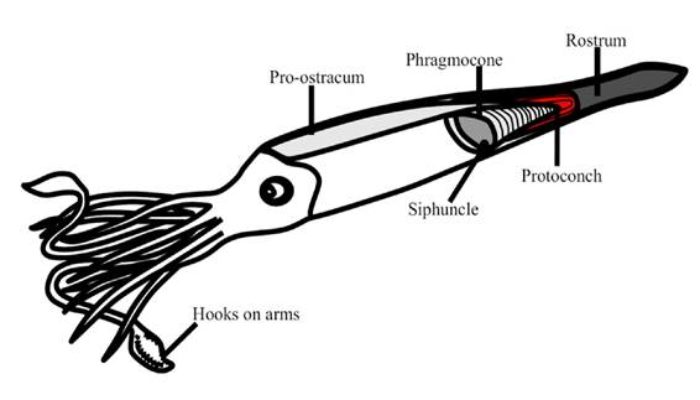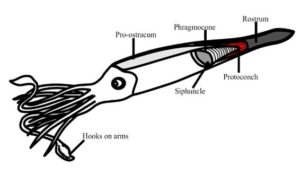
Belemnites are a group of now extinct marine coleoids cephalopods that lived during the Mesozoic (240 Mya – 65 Mya). Unlike modern squids, belemnites had a hard internal skeleon made of calcium carbonate called a rostrum. Like many fossil groups, belemnites have been associated with numerous myths and legends in folklore.
Belemnites take their name from the Greek word belemnon meaning dart or javelin. The term rostrum comes from the name of the battering rams found at the front of ancient Roman and Greek ships in Antiquity. The fossilised rostra were widely believed to have been flung down as darts from heaven during thunderstorms (thunderbolts). Such beliefs were widespread also during the Medieval Period in Europe with houses in parts of southern Germany where rostra were placed under the roof tiles to help prevent lightning strikes. Similar stories are also found in the Netherlands with these ‘donderstenen’ or ‘Donar’s stones’ (Donar being the Old High German word for Thor) were kept in the roof to protect houses from lighting strikes (University of Manchester, 2020).
Belemnites association with lighting dates back even further than Medieval Europe with objects that resemble belemnites found in ancient Egyptian hieroglyphics and used to symbolise lightning and the fertility god Min (Najovits, 2004). In Scandinavian folklore, belemnites are regarded as elf, gnome, and pixie candles. In some areas they are still called vateljus which in Swedish literally means gnomes’ lights. Throughout Europe it was widely believed that belemnites were the points of pixie-arrows and were sometimes referred to as ‘elf-bolts’ (University of Manchester, 2020).
Belemnites were also thought to have healing properties and prevent nightmares across European folklore. In Lithuania for example it was thought that snake bites could be miraculously cured by rubbing a belemnite rostrum on a snake bite whilst chanting the following spell (University of Manchester, 2020):
“Three times nine times comes Perkunas’ thunder from the sea.
Three times nine times bullets strike the swelling under the stone.
This man regains the health he enjoyed before!”
In western Scotland belemnites are known as ‘bat’ and ‘bot’ stones and were soaked in water given to water to calm horses down. In southern England, especially in Dorset – home to the world-famous Jurassic Coast – grounded up belemnite powder was blown into peoples and horses’ eyes (presumably fail) to cure sore eyes and rheumatism (University of Manchester, 2020).
The scientific mention of a belemnite in writing comes from the Greek philosopher Theophrastus (c. 371 – c. 287 BC), in his book De Animalibus Quæ Dicuntur Invidere who described belemnites as lyngurium (lynx urine which had been buried and solidified). Roman natural philosopher Pliny the Elder (AD 23/24 – 79) did not support Theophrastus’s hypothesis and instead classified it as a gemstone and coined the term a belemnite for the first time. Although Pliny the Elder was on the right track, he did not recognise belemnites as fossils (de Blainville, 18. A highly recommended book on Greco-Roman palaeontology would be The First Fossil Hunters: Dinosaurs, Mammoths, and Myth in Greek and Roman Times by Adrienne Mayor – though unfortunately it does not mention belemnites.
It was German mineralogist Georgius Agricola in 1546 who first realised that belemnites were fossils and later authors gave several hypotheses to its nature in life, including rostra being shellfish, echinoid spines, sea cucumbers, coral polyps, or some internal shell (de Blainville, 1827). In 1823, English naturalist John Samuel Miller classified belemnites as cephalopods, comparing the newly discovered phragmocone remains to that of a nautilus, and concluding a resemblance to the cuttlefish Sepia. Miller (1826) described the genus Belemnites along with 11 species. This classification was confirmed when the first impressions of belemnite soft body anatomy were described by English palaeontologist Richard Owen in 1844.
From the 1950’s onwards, belemnites have played a significant role in palaeoclimate reconstructions due to their low-Mg calcite shells (e.g., Urey, 1951; Engust, 1961; Rosales et al., 2004; Ullmann et al., 2015 and many, many, many more). Most of the research on belemnites is centred on their geochemistry and for good reason – they provide high resolution data sets for paleoclimate reconstructions are their rostra retain the original geochemical and isotopic signatures from the Mesozoic.
References
de Blainville, H.H.D. (1827). Mémoire sur les bélemnites, considérées zoologiquement et géologiquement. Paris: Paris F.G. Levrault.
Miller, J. S. (1826). Observations on Belemnites. Transactions of the Geological Society of London, 2 (1), 45–62.
Najovits, S. R. (2004). Egypt, trunk of the tree: a modern survey of an ancient land. Algora Publishing: New York.
Owen, R. (1844). A Description of Certain Belemnites, Preserved, with a Great Proportion of Their Soft Parts, in the Oxford Clay, at Christian-Malford, Wilts. Philosophical Transactions of the Royal Society of London, 134, 65-85.
Rosales, I., Robles, S., and Quesada, S. (2004). Elemental and oxygen isotope composition of Early Jurassic belemnites: salinity vs. temperature signals. Journal of Sedimentological Research, 74, 342-354.
Ullmann, C.V., Frei, R., Korte, C., and Hesselbo, S.P. (2015). Chemical and isotopic architecture of the belemnite rostrum. Geochimica et Cosmochimica Acta, 159, 231-243.
University of Manchester. (2020). Fossil myths & Legends – Belemnites. Available: http://harbour.man.ac.uk/mmcustom/narratives/display.php?irn=1280&QueryPage=/mmcustom/narratives/index.phpU
Urey, H.C., Lowenstam, H.A., and McKinney, C.R (1951). Measurement of paleotemperatures and temperatures of the Upper Cretaceous of England, Denmark, and the southeastern United-States. Geological Society of America Bulletin, 62, 399-416.



Astu
Nice work, but in eastern and southern Europe there is also folklore related to the belemnites.
Greetings
Astu
Dan Chure
I am a paleontologist and have been trying to find out more about belemnites and Min but the only reference I come across is the Najovits which you cite and that just states it as a fact without any reference to another study. I have no idea if that is just an inference or belemnites have been found in some context supporting that contention. The image of Min you show is widely referenced but I am not sure they are belemnites next to Min, they might also be the spike lettuce associated with Min. Any thoughts? Thanks.
Adrienne Mayor
Mayor mentions belemnites on pp 71, 275 of The First Fossil Hunters
Dan Chure
Yes you do. But neither of those help with understanding what made an Egyptologist identify the objects in the carving as a table of belemnite guards. It was not a paleontologist who claimed that. But I can’t find or see a quote from the work that made the claim first.
jetbet iran
This is the type of information I’ve long been trying to find Thank you for writing this information. jetbet iran
mt68
We are really grateful for your blog post You will find a lot of approaches after visiting your post Great work. mt68